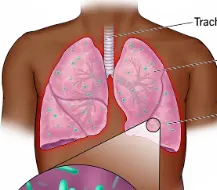Tuberculosis (TB) is a disease caused by germs that are spread from person to person through the air. TB usually affects the lungs, but it can also affect other parts of the body, such as the brain, the kidneys, or the spine. This fact sheet provides basic information on the transmission, symptoms, testing, and treatment of TB.
A tiny amount of a substance called tuberculin is injected just below the skin on the inside of one forearm. Within 48 to 72 hours, a health care worker will check your arm for swelling at the injection site. The size of the raised skin is used to determine a positive or negative test.
This test is seeing if your immune system reacts, or has made an antibody, to tuberculosis. A positive test indicates you likely have either a latent TB infection or active TB disease. People who had a TB vaccination might get a positive test even if they have no infection. A negative test means that your body didn’t react to the test. It doesn’t necessarily mean you don’t have an infection.
A sample of blood is sent to a lab. One lab test finds out whether certain immune system cells can “recognize” tuberculosis. A positive test shows that you have either a latent TB infection or active TB disease. Other tests of the blood sample can help determine if you have active disease.
A negative result means you likely do not have a TB infection.
A chest X-ray can show irregular patches in the lungs that are typical of active TB disease. Your health care provider may take a sample of the mucus that comes up when you cough, also called sputum. If you have active TB disease in your lungs or voice box, lab tests can detect the bacteria.
A relatively quick laboratory test can tell if the sputum likely has the TB bacteria. But it may be showing bacteria with similar features. Another lab test can confirm the presence of TB bacteria. The results often take several weeks. A lab test also can tell if it’s a drug-resistant form of the bacteria. This information helps your health care provider choose the best treatment. If you have a latent TB infection, your health care provider may begin drug treatments. This is especially true for people with HIV/AIDS or other factors that increase the risk of active TB disease. Most latent TB infections are treated for three or four months.
Active TB disease may be treated for four, six or nine months.










